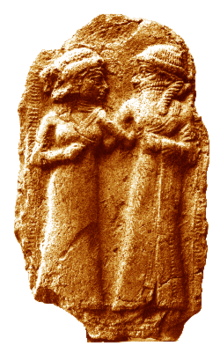Dumuzid
Dumuzid the Shepherd | |
|---|---|
 The marriage of Inanna and Dumuzid | |
| Other names | Dumuzi |
| Title | King of Sumer |
| Spouse | Inanna |
Dumuzid or Dumuzi, called "the Shepherd", from Bad-tibira in Sumer, was, according to the Sumerian King List, the fifth predynastic king in the legendary period before the Deluge. The list further states that Dumuzid ruled for 36,000 years.
In Sumerian epic literature
"Dumuzid the Shepherd" is also the subject of a series of epic poems in Sumerian literature. However, he is described in these tablets as king of Uruk, the title given by the King List to Dumuzid the Fisherman — a distinct figure said to have ruled sometime after the Flood, in between Lugalbanda "the Shepherd" and Gilgamesh.
Among the mythical compositions involving Dumuzid the Shepherd are:
- Inanna's descent to the netherworld: Inanna, after descending to the underworld, is allowed to return, but only with an unwanted entourage of demons, who insist on taking away a notable person in her place. She dissuades the demons from taking the rulers of Umma and Bad-tibira, who are sitting in dirt and rags. However, when they come to Uruk, they find Dumuzid the Shepherd sitting in palatial opulence, and seize him immediately, taking him into the underworld as Inanna's substitute.
- Dumuzid and Ngeshtin-ana: Inanna gives Dumuzid over to the demons as her substitute; they proceed to violate him, but he escapes to the home of his sister, Ngeshtin-ana (Geshtinanna). The demons pursue Dumuzid there, and eventually find him hiding in the pasture.
- Dumuzid and his sister: Fragmentary. Dumuzid's sister seems to be mourning his death in this tablet.
- Dumuzid's dream: In this account, Dumuzid dreams of his own death and tells Ngeshtin-ana, who tells him it is a sign that he is about to be toppled in an uprising by evil and hungry men (also described as galla, 'demons') who are coming to Uruk for the king.[1] No sooner does she speak this, than men of Adab, Akshak, Uruk, Ur, and Nippur are indeed sighted coming for him with clubs. Dumuzid resolves to hide in the district of Alali, but they finally catch him. He escapes from them and reaches to the district of Kubiresh, but they catch him again. Escaping again to the house of Old Woman Belili, he is again caught, but then escapes once more to his sister's home. There he is caught a last time, hiding in the pasture, and killed.
- Inanna and Bilulu: This describes how Inanna avenges her lover Dumuzid's death, by killing Old Woman Bilulu (or Belili).
Deity
Later poems and hymns of praise to Dumuzid indicate that he was later considered a deity, a precursor of the Babylonian god Tammuz. In Tablet 6 of the Standard Babylonian Epic of Gilgamesh, Gilgamesh rebuffs Ishtar (Inanna), reminding her that she had struck Tammuz (Dumuzid), "the lover of [her] youth", decreeing that he should "keep weeping year after year". Pictured as a bird with a broken wing (an allallu-bird, possibly a European or Indian Roller),[2][3] Dumuzid now "stays in the woods crying 'My wing!'" (Tablet 6,ii,11-15).[4] Another possible identification for this bird [according to whom?] is the Northern or Red-wattled Lapwing, both of which species are well known for their distraction displays where a wing is dragged on the ground as if broken in order to divert a potential predator from the lapwing's nest. The mournful two-note call of these birds also evokes the Akkadian kappi, "My wing!".
In a chart of antediluvian generations in Babylonian and Biblical traditions, William Wolfgang Hallo associates Dumuzid with the composite half-man, half-fish counselor or culture hero (Apkallu) An-Enlilda, and suggests an equivalence between Dumuzid and Enoch in the Sethite Genealogy given in Genesis chapter 5.[5]
Sources
- ^ Dina Katz, The image of the netherworld in the Sumerian sources, 2003, p. 152: "At the beginning of the story they are specifically labelled as bandits, then they are 'evil men' or galla. The formulaic description of the galla as netherworld creatures occurs only after they encounter Dumuzi, but is immediately followed by their description as natives of five Sumerian cities. The description of the bandits rising against Dumuzi from an ambush is reminiscent of the original tradition." See also: Bendt Alster, Dumuzi's dream: Aspects of oral poetry in a Sumerian myth (1972), and Reallexikon der Assyriologie, Band 8 p. 548.
- ^ Dalley, Stephanie (tr.), Myths from Mesopotamia, Oxford University Press, Oxford, 1991, p. 129, n. 56
- ^ Sandars, Nancy K., The Epic of Gilgamesh, Penguin Books, Harmondsworth, 1960, 1972, p. 86
- ^ Dalley, Stephanie (tr.), Myths from Mesopotamia, Oxford University Press, Oxford, 1991, pp. 78-79
- ^ Hallo, William W. and William Kelly Simpson, The Ancient Near East: A History, Harcourt Brace Jovanovich, Inc., New York, 1971, p. 32
